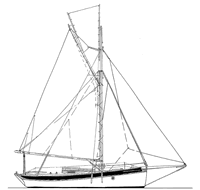Cornish Crabber 30
Coastal cruiserr
There's a sailing world where tenths of a knot mean nothing, and VMG is measured in smiles on the skipper's face. "Going to weather" means anything shy of 45 degrees apparent. Getting there quickly is not as important as getting there in style. Welcome to the world of the Cornish Crabbers. These cutters have been built at the mouth of the Camel Estuary in North Cornwall for more than 25 years and have a very strong following. The company's current models range from a 12-footer to the new 30-footer designed by Roger Dongray.
This is a full-keel design. There is no distinction between where the forefoot ends and the keel begins. Draft is 3 feet, 6 inches, but there is a plate centerboard you can lower that adds another 21 inches to the draft. This centerboard is housed entirely below the cabin sole. Beam is moderate with an L/B of 3.15. The beam is carried into the ends. The plumb stem also means that volume is carried into the bow. The LOD of 30 feet is deceptive. This is a big 30-footer. The D/L for the gaff rig is 366 indicating what you would imagine to be a rather heavy boat. But it isn't. Its displacement is moderate. The wide "planks" of the fiberglass hull form give the Crabber almost a multi-hard-chine look. These lines accentuate the shapeliness of the hull and enhance the vintage look. I love the perky sheer spring of this design.
My favorite feature of this rig is the traditional way the bowsprit is set off center, passing alongside the pronounced stem timber. Photos in the brochure show that the outboard end of the bowsprit is on centerline, but the inboard end with its samson post fixture is offset to starboard. In the old days these bowsprits were reefable.
You can choose either a Bermuda-rigged Crabber or a gaff-rigged Crabber. As long as you are going with this type of boat you might as well go with the gaff rig. I suspect the Bermuda rig will be faster upwind and the gaff rig faster downwind. The gaff rig has 34 square feet more sail area than does the Bermuda rig. With flying jib, staysail, mainsail and main topsail you will have plenty of strings to pull on this boat. Look at that sailplan. This is a great looking boat. Any idiot can make a Mumm 30 go fast. It takes a real sailor to get the best out of a gaff-rigged Crabber.
The accommodation plan is laid out for four cruisers. The settees are shorter than what I would consider berth length but the V-berth and quarter berths are generous. Finished in all mahogany this interior is stunning. The entertainment center is the liquor cabinet.
If you go with the optional teak deck you can go wild with the varnish and create a real vintage look. Add the wine-red sails, throw the GPS overboard and you can easily imagine yourself transported back to 1912. Come to think of it, that's a really appealing idea right now. Although I think I'll hang on to the GPS.

Comments